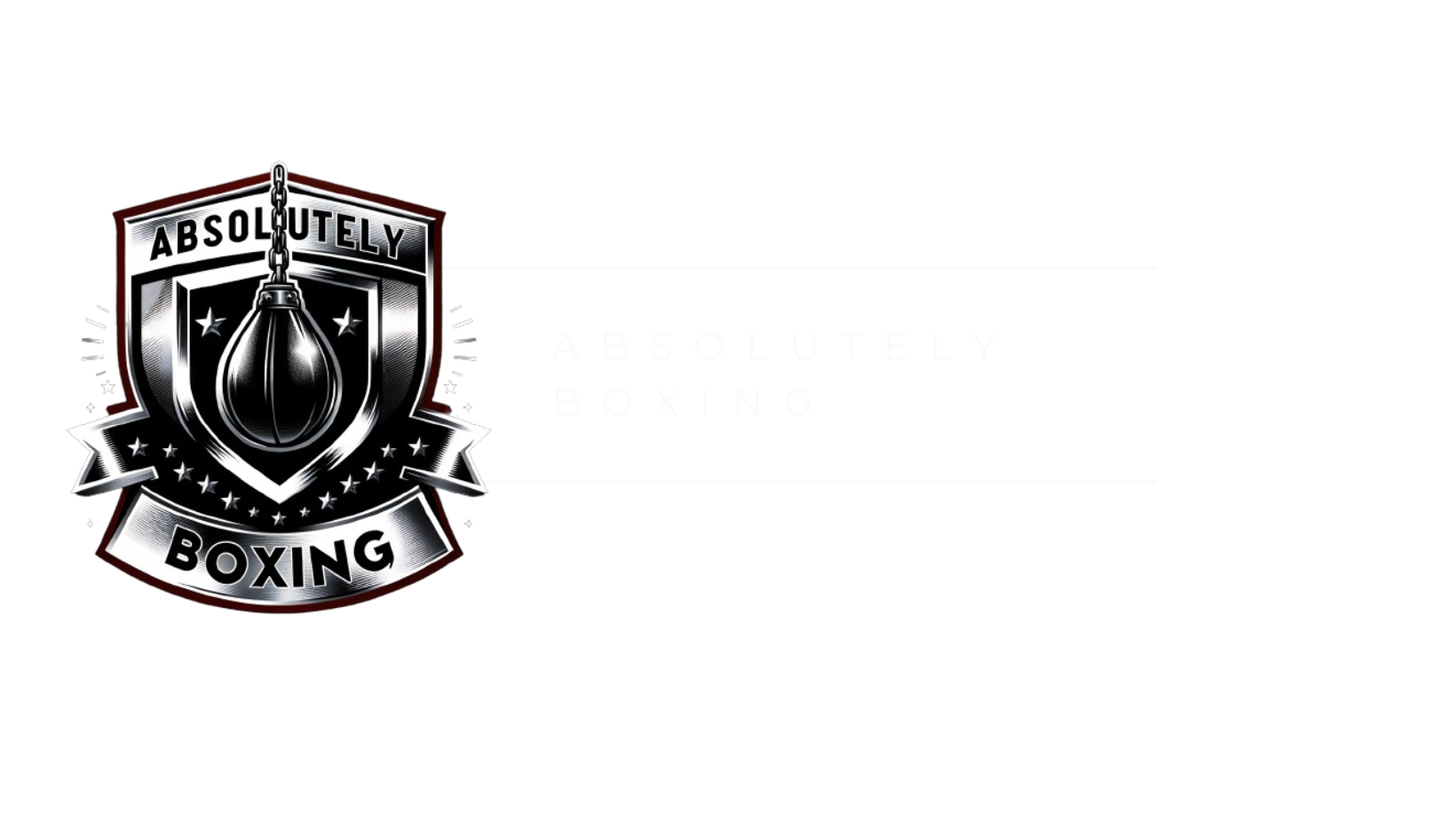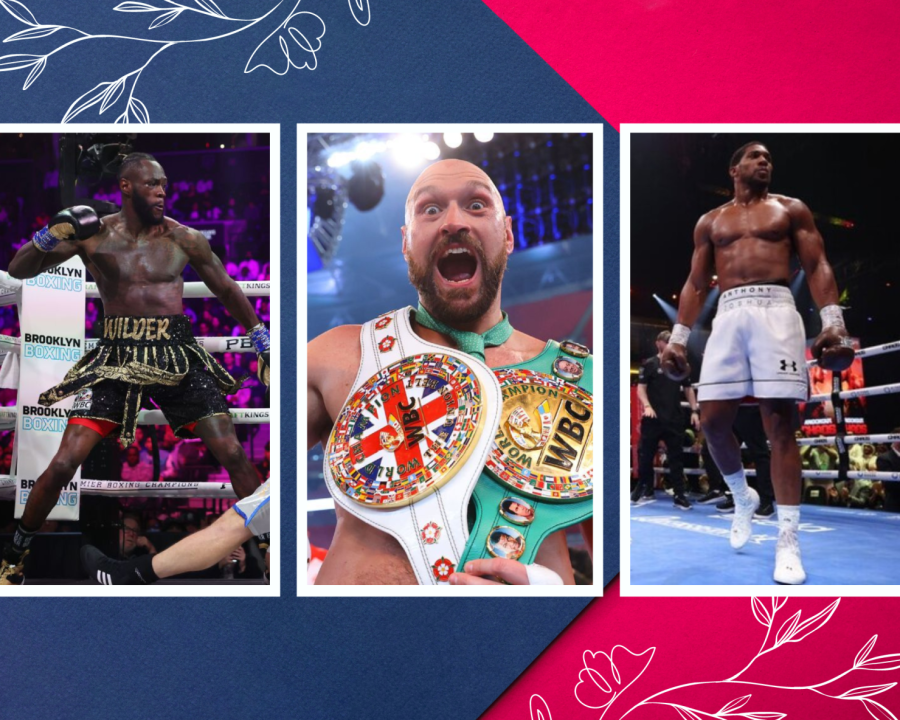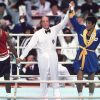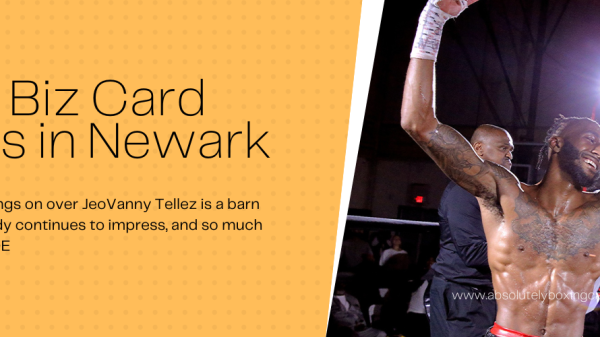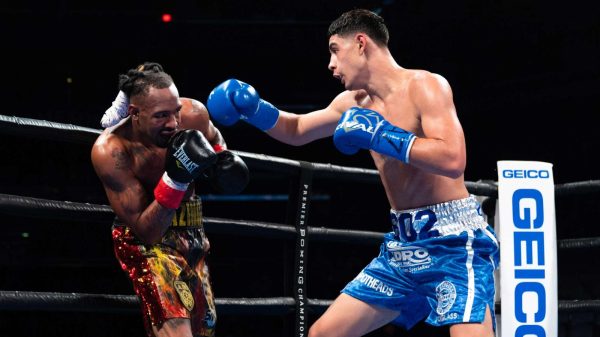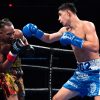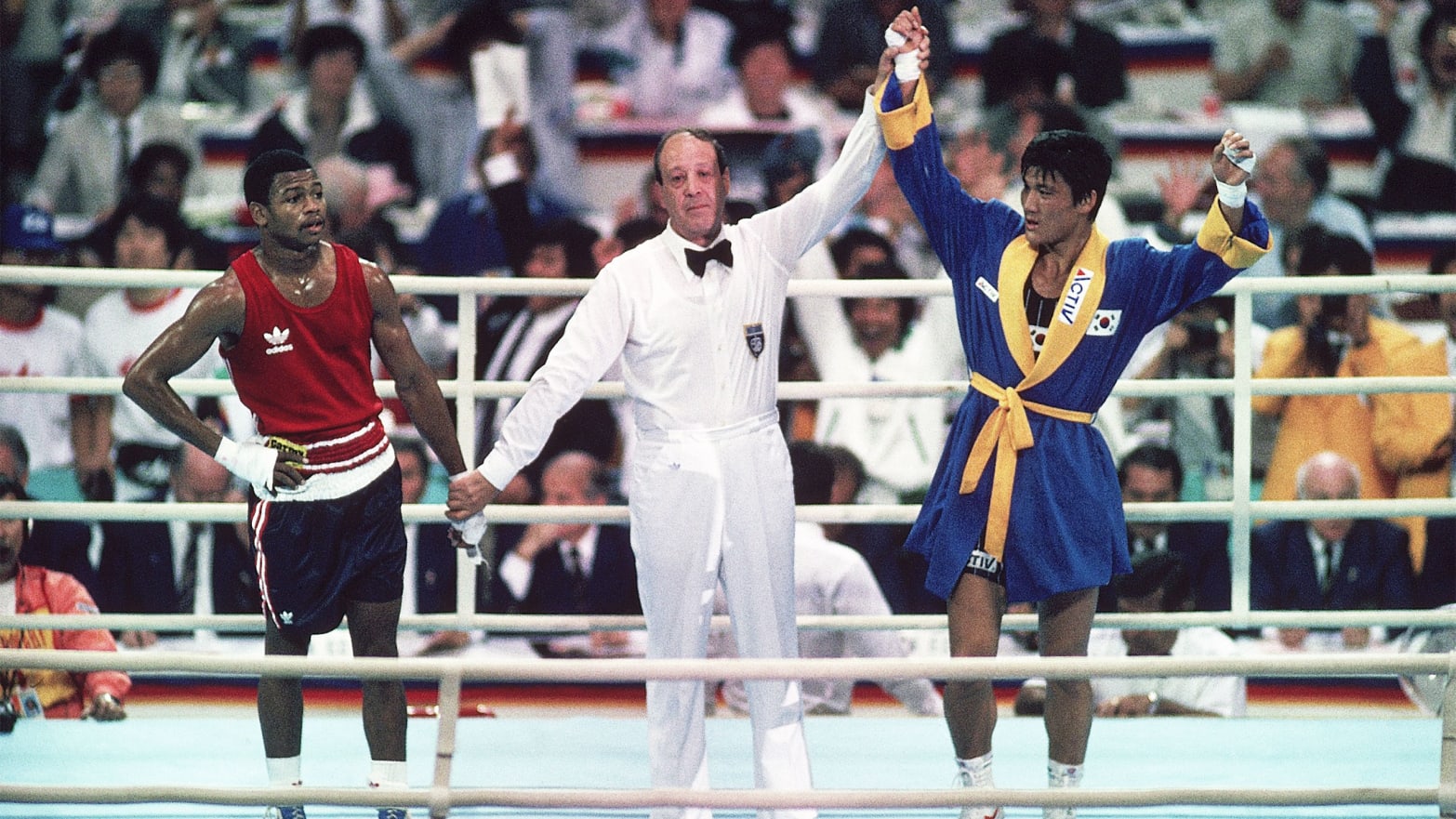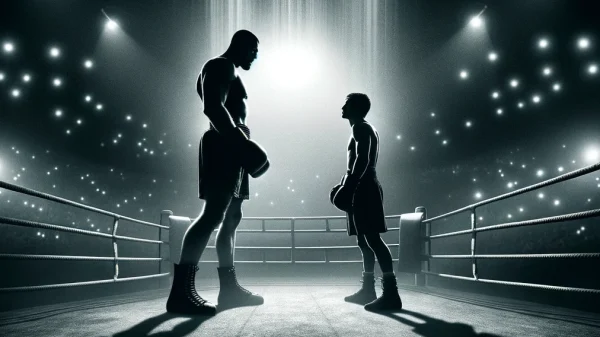With Daniel Dubois’ recent victory over Anthony Joshua (26-4-0, 22 KOs), a significant chapter in heavyweight boxing has seemingly closed, marking the end of a golden but unsettled era. While the physical battles in the ring continue, the truth is that the heavyweight division’s most vibrant days of the last decade are likely behind us. The likes of Deontay Wilder (43-2-1, 42 KOs) and Tyson Fury (33-0-1, 24 KOs), though still formidable, have seen their primes slip away.
Wilder has not been the same since his grueling trilogy against Fury, a series of fights that defined him but also perhaps diminished him. Tyson Fury, who might still have a little left in the tank, has hinted that his reign could be nearing its conclusion, especially after his defeat to Oleksandr Usyk (21-0-0, 14 KOs). At 35 years old, even the “Gypsy King” knows the wear and tear of a long career will eventually catch up to him. As for Anthony Joshua, the fighter who once seemed poised to rule the division indefinitely, his star has faded after losses to Usyk and now Dubois.
Reflecting on what this generation of heavyweights has meant, it’s clear that it was both great and incomplete. This trio of men were the giants of their time, and as much as their battles entertained us, they also left much to be desired. Politics, egos, and the complexities of boxing promotion kept them from realizing their full potential. Unlike the era of Muhammad Ali, Joe Frazier, and George Foreman, where all three fought each other at their peaks, only Fury and Wilder were able to settle their differences in the ring. Joshua, who once held multiple titles, was ultimately a spectator in their rivalry.
But despite the missed opportunities, we must recognize how incredible these fighters were in their prime. They belong in the same conversation as the great heavyweights of history. Their impact, however, won’t fully be appreciated until the years pass, and the dust settles on a chaotic but exciting era in the sport. This article takes a closer look at their stories—at their triumphs and failures, and how they shaped the heavyweight division of the 21st century.
The Rise of a Bright Star: Tyson Fury’s Journey
Tyson Fury’s journey to the top of the heavyweight division is one filled with twists, turns, and dramatic highs and lows. His amateur career began humbly, and unlike Joshua, who would go on to win Olympic gold, Fury was denied the opportunity to represent his country at the 2008 Beijing Olympics. Despite being a promising talent, he was passed over for the more highly touted David Price. This decision, however, didn’t deter Fury. If anything, it only fueled the hunger that would define his career.
Turning pro later that same year, Fury quickly made a name for himself as a dangerous and unpredictable fighter. Standing at 6’9″ with a reach that seemed to stretch across the ring, Fury was physically imposing, but it was his movement and agility—traits uncommon for a man his size—that made him so unique. Early in his professional career, around 2010, Fury began a relationship with the legendary Emanuel Steward after a visit to the iconic Kronk Gym in Detroit. Although Steward never officially trained Fury, he recognized something special in the young heavyweight, even going as far as to predict that Fury would be the next dominant force in the division.
Fury’s first significant victory came in 2011 when he defeated Derek Chisora to claim the British heavyweight title. It was a fight that displayed his full range of talents—his ability to outbox opponents, his stamina, and his toughness. However, it wasn’t until 2015 that Fury’s star truly rose to its highest point. That year, in one of the most significant upsets in boxing history, Fury defeated Wladimir Klitschko (64-5-0, 53 KOs) to end the Ukrainian’s decade-long reign over the heavyweight division. It was a performance that shocked the boxing world; Fury didn’t just win, he outclassed Klitschko, taking a unanimous decision on all scorecards.
For the first time in years, the heavyweight division had a new king, and it was clear that Fury was unlike any champion we’d seen before. His awkward, unorthodox style, combined with his psychological tactics, made him a nightmare for any opponent. He had conquered the mountain, but his problems were just beginning.
The American Powerhouse: Deontay Wilder’s Knockout Legacy
While Fury was building his career in the U.K., another fighter was making waves across the Atlantic—Deontay Wilder. Known for his devastating knockout power, Wilder quickly garnered attention by knocking out his first 32 opponents, a streak that established him as one of the most feared men in the sport. However, with this incredible streak came the inevitable criticisms. Many doubted the quality of Wilder’s opposition, accusing him of taking on lesser fighters to pad his record.
Wilder’s big break came in 2013 when he knocked out the experienced Audley Harrison, which earned him some much-needed respect. Yet, even with that victory, the whispers about his lack of high-level competition persisted. It wasn’t until 2015 that Wilder began to solidify his legacy when he fought Bermane Stiverne (25-5-1, 21 KOs) for the WBC heavyweight title. In that fight, Wilder showcased more than just his knockout power; he displayed his ability to box over 12 rounds, winning a unanimous decision to claim his first major championship belt. In doing so, he became the first American heavyweight champion since Shannon Briggs in 2007.
For many, Wilder’s victory over Stiverne was a turning point. It marked the beginning of his reign as a legitimate world champion. However, doubts about Wilder’s boxing fundamentals and his resume persisted. His detractors argued that his raw power was enough to beat mid-tier opponents, but they questioned whether it would be enough against elite competition. These criticisms would dog him for most of his career.
The Olympic Golden Boy: Anthony Joshua’s Early Career
While Deontay Wilder and Tyson Fury were busy carving out their professional careers, a new star was emerging in the U.K. Anthony Joshua’s (26-3-0, 22 KOs) journey began in the amateur ranks, where he built a reputation as a formidable force. His crowning moment came at the 2012 London Olympics, where he captured the gold medal in front of an adoring hometown crowd. It was a pivotal victory, not just for Joshua, but for British boxing as a whole. The U.K. had produced an Olympic champion in the sport’s most prestigious weight class, and with that gold medal came the kind of attention and expectations that would shape the early part of Joshua’s career.
Joshua’s amateur success paved the way for his professional debut in 2013, where he signed with Eddie Hearn’s Matchroom Boxing. From the moment Joshua turned pro, it was clear that he had all the tools to become a global superstar. Standing at 6’6”, with a muscular build that looked like it was sculpted in a lab, Joshua was not just a fighter, he was a marketing dream. His knockout power, combined with his clean-cut image and charisma, made him an instant favorite with fans and promoters alike.
Under Hearn’s guidance, Joshua’s career moved at a lightning-fast pace. By 2015, just two years after his professional debut, he had already established himself as a major player in the heavyweight division. That year, Joshua faced Dillian Whyte (29-3-0, 19 KOs), a long-time rival from their amateur days. The fight was highly anticipated, with fans eager to see how Joshua would fare against someone who had previously beaten him. The bout was a back-and-forth slugfest, with Whyte rocking Joshua with a vicious left hook in the second round. But Joshua showed his resilience, recovering quickly and delivering a knockout blow in the seventh round to secure victory. The win over Whyte not only avenged his amateur loss but also proved that Joshua had the heart and toughness to match his physical gifts.
With the Whyte victory under his belt, Joshua was now being fast-tracked toward a world title shot. In April 2016, he faced reigning IBF world heavyweight champion Charles Martin (28-3-1, 25 KOs) in a fight that many viewed as Joshua’s coming-out party on the global stage. Martin, who had won the vacant IBF title just a few months earlier, was seen as the underdog, despite being the champion. The fight was a brief but explosive affair, with Joshua knocking Martin down twice in the second round to claim his first world title. The ease with which Joshua dispatched Martin sent shockwaves through the boxing world. A new heavyweight champion had arrived, and he looked unstoppable.
With Joshua now holding the IBF title, and Wilder and Fury both in possession of belts, the heavyweight division was suddenly alive with excitement. For the first time since the days of Mike Tyson and Lennox Lewis, there was genuine buzz around the division. The Klitschko brothers had dominated the heavyweight scene for over a decade, but their cautious, clinical style had drained much of the life out of the sport. Fans longed for the days of explosive knockouts and dramatic showdowns, and in Joshua, Wilder, and Fury, they had three fighters who brought exactly that.
The stage was set for a new golden age in heavyweight boxing, one filled with a variety of styles, personalities, and rivalries. Joshua, the Olympic golden boy with a knockout punch; Wilder, the American powerhouse with a questionable resume but undeniable knockout power; and Fury, the unorthodox and unpredictable technician with a penchant for mental warfare. It seemed inevitable that these three men would collide in a series of high-stakes bouts that would define the era. But, as it so often happens in boxing, things didn’t go according to plan.
The Wheels Almost Come Off: Fury’s Fall and Wilder’s Quest for Legitimacy
Tyson Fury’s stunning victory over Wladimir Klitschko in 2015 should have marked the beginning of a long and prosperous reign at the top of the heavyweight division. Instead, it marked the beginning of a dark and tumultuous chapter in his life. In the months following his historic win, Fury’s personal struggles began to surface. He gained a significant amount of weight, and soon after, admitted to battling depression, anxiety, and substance abuse. These issues, coupled with his suspension by the UK Anti-Doping Agency for testing positive for nandrolone, led to Fury being stripped of his titles and stepping away from the sport altogether.
As Fury spiraled out of control, Deontay Wilder was establishing himself as the premier heavyweight of the era—at least in terms of title defenses. Wilder, who had captured the WBC heavyweight title in 2015 with a unanimous decision over Bermane Stiverne (25-5-1, 21 KOs), was racking up victories, but many of them came against less-than-stellar opposition. Despite his impressive record and incredible knockout power, Wilder still struggled to earn respect from boxing purists, who criticized the level of competition he was facing.
In 2016, Wilder scored a highlight-reel knockout against Artur Szpilka (24-5-0, 16 KOs), delivering a devastating punch in the ninth round to end the fight. The victory was impressive, but it did little to enhance his credibility in the eyes of his critics. Later that year, Wilder faced Chris Arreola (38-7-1, 33 KOs), a durable but aging veteran. In that bout, Wilder broke his hand and tore his bicep but still managed to win by stoppage. However, these victories were seen more as placeholders than significant achievements.
Wilder knew that if he was going to cement his place as the top heavyweight, he needed to face and defeat a dangerous, legitimate contender. Enter Luis Ortiz (33-3-0, 28 KOs), the Cuban southpaw known as the “boogeyman” of the heavyweight division. Ortiz was a technically skilled counterpuncher with knockout power, and most top heavyweights avoided him. Wilder, eager to prove himself, agreed to fight Ortiz in what was expected to be a career-defining bout.
But before the fight could happen, Ortiz tested positive for banned substances, forcing the bout to be canceled. The WBC mandated that Wilder face Bermane Stiverne in a rematch instead, a fight that no one wanted to see. The first fight between Wilder and Stiverne had been a relatively one-sided affair, with Wilder winning easily on points. The rematch was even less competitive. Stiverne, who was visibly out of shape and disinterested, was knocked out in the first round in one of the most lackluster title fights in recent memory.
The Stiverne rematch did nothing to enhance Wilder’s standing, but his time to prove himself would come soon enough. In 2018, after Ortiz was cleared to fight again, Wilder finally got his chance to face the Cuban, and what followed was one of the greatest heavyweight fights of the decade.
The King Returns and the Division Heats Up
Deontay Wilder’s moment of truth arrived in March 2018, when he finally got his long-awaited shot at Luis Ortiz (33-3-0, 28 KOs), the Cuban southpaw and a feared contender who had been avoided by many in the division. Ortiz, known as “King Kong,” presented a formidable challenge, and fans eagerly anticipated the matchup. What transpired that night was nothing short of a classic heavyweight bout, showcasing everything that made Wilder both thrilling and polarizing as a fighter.
The fight was dramatic, and Wilder’s knockout power was once again on full display, but it wasn’t without its harrowing moments. Wilder entered the 10th round with a slim one-point lead on the scorecards, having been rocked several times throughout the bout. In the seventh round, Ortiz had Wilder all but finished—Wilder was visibly dazed, standing on shaky legs, and instinctively clinging to survival until the bell mercifully sounded. Ortiz poured on the pressure in the eighth round, continuing his assault, but Wilder somehow held on. Then came the knockout in the 10th round. In a sudden turn of events, Wilder unleashed his trademark power, dropping Ortiz and retaining his WBC belt.
The victory over Ortiz was a defining moment in Wilder’s career. Ortiz had been avoided by the top heavyweights for years, his awkward style and powerful counterpunching a nightmare for anyone daring to face him. By beating him, Wilder had silenced many of his critics and solidified his standing as a legitimate heavyweight champion. His power was now paired with undeniable grit, resilience, and the ability to overcome adversity in the ring.
Meanwhile, Anthony Joshua’s career was hitting new heights. In 2017, he faced the aging but still dangerous Wladimir Klitschko in what became one of the greatest heavyweight battles of recent times. Joshua knocked Klitschko down in the fifth round, only to find himself on the canvas two rounds later. It was a back-and-forth affair, but Joshua managed to recover and finish Klitschko in the 11th round. The victory catapulted Joshua to international stardom and positioned him as one of the most exciting fighters in the division.
Following his win over Klitschko, Joshua continued to clean out the heavyweight division, defeating Joseph Parker and Alexander Povetkin in back-to-back bouts. With Joshua now holding multiple belts and Wilder solidifying his status with the Ortiz win, the stage was set for a unification bout between the two champions—the kind of fight that hadn’t been seen in the heavyweight division for decades. The world was eager for Joshua and Wilder to collide, and it seemed like only a matter of time before they did.
While Wilder and Joshua were on a collision course, Tyson Fury was making a comeback. Fury had been out of the ring for two and a half years, battling personal demons, but by 2018, he was ready to make his return. After losing over 100 pounds and committing himself to mental and physical health, Fury was back in the gym, preparing for his next chapter. His return was met with skepticism by many. His first comeback fight against Sefer Seferi was more of an exhibition than a real test. Though he won, few were impressed. Fury seemed like a man simply happy to be back in the ring, but the big question loomed: could he really regain his old form? At this point, Fury was considered a distant third in the division, trailing behind Wilder and Joshua in terms of credibility and momentum.
But Fury wasn’t done yet, and as 2018 progressed, his return to the top would become one of the most remarkable stories in recent boxing history.
Disaster Strikes: The Fight That Never Happened
As 2018 rolled on, boxing fans were growing impatient. Negotiations between Anthony Joshua and Deontay Wilder for a unification bout had begun, and it seemed like the heavyweight division was about to crown an undisputed champion. The excitement was palpable, and the stakes were enormous. Joshua, the golden boy of British boxing, and Wilder, the knockout artist from Alabama, were on a collision course that could define the era. But then disaster struck, not inside the ring, but in the boardrooms.
Wilder’s team offered Joshua a massive $50 million guarantee to take the fight, a sum that should have been impossible to turn down. Yet, to the shock of many, Eddie Hearn and Joshua’s camp declined the offer. Instead, Hearn countered with a considerably smaller $15 million offer for Wilder, which Wilder’s team promptly rejected. The negotiations, which had been billed as the pathway to the biggest fight in boxing, quickly broke down.
At the heart of the issue was a difference in strategy. Hearn was focused on building Joshua’s brand for the long term, more concerned with preserving his fighter’s marketability than risking everything on one massive payday. Wilder, on the other hand, wanted the fight and was willing to make it happen on less favorable terms. With both sides unable to agree, the dream fight fell apart. Fans were left disappointed, and the heavyweight division was deprived of what could have been a defining showdown.
As Joshua’s camp pursued other opponents, Wilder turned his attention to Tyson Fury, who had emerged from his comeback victorious and looking for a title shot. The decision to fight Fury was met with mixed reactions. Some viewed Fury as a spent force, still rusty from his time away from the sport. Others, however, knew that a fully fit Tyson Fury could be one of the most dangerous fighters in the world. Wilder was willing to take that chance, and the fight was made.
On December 1, 2018, the world was treated to one of the most significant heavyweight boxing matches in decades.
The Greatest Heavyweight Fight of the Last 40 Years
When Tyson Fury stepped into the ring to face Deontay Wilder in December 2018, it felt like the entire boxing world was watching. The fight carried an aura that few matchups in recent history had. This was not just about belts or bragging rights; this was a cultural event. In many ways, it was the most important heavyweight bout since Mike Tyson’s comeback against Peter McNeely, and arguably the biggest boxing match since Mayweather vs. Pacquiao.
This fight, the first in what would become an iconic trilogy, was unlike anything the division had seen in recent times. Wilder’s destructive power versus Fury’s defensive genius and mental toughness—it was a classic clash of styles. Fury, known for his unorthodox movement and defensive brilliance, controlled much of the fight with his footwork and jab, frustrating Wilder and neutralizing his power. By the time the fight reached the 12th round, it seemed Fury was on his way to a comfortable decision victory. But Wilder, never out of a fight, had one final trick up his sleeve.
In the closing moments of the final round, Wilder connected with a thunderous right hand that sent Fury crashing to the canvas. For most fighters, it would have been lights out. But not for Fury. In one of the most dramatic moments in boxing history, Fury, who looked unconscious for several seconds, miraculously rose to his feet, beating the referee’s count. The crowd was stunned. Wilder, believing he had won, could hardly comprehend what had just happened. Fury’s recovery became an instant part of boxing lore.
The bout ended in a controversial split draw, with many believing Fury had done enough to win. Wilder retained his WBC title, but the result left a bitter taste for both fighters. The fight, however, had delivered in every way imaginable. It was the kind of event that people would talk about for years—an iconic moment that cemented both Wilder and Fury’s legacies in the sport.
We didn’t realize it at the time but the moment Fury pulled himself off the mat would be the high water mark for this generation.
The Trio Begins to Unwind
As 2019 unfolded, the heavyweight division seemed to revolve around what would happen next between Wilder and Fury. Their rivalry had captivated the world, and a rematch was inevitable. But while they geared up for their respective fights against lesser opponents, Anthony Joshua was still riding high as the division’s cash cow. However, Joshua’s next fight would shatter the illusion of his dominance.
Joshua was scheduled to defend his titles against a relatively unknown Mexican-American fighter named Andy Ruiz Jr. (35-2-0, 22 KOs). Ruiz, short and stocky, didn’t look the part of a world-beating heavyweight. Tyson Fury himself had predicted that Ruiz would give Joshua trouble, but most dismissed the fight as a routine title defense for the British star. Then came the third round.
Joshua knocked Ruiz down early in the round, and most assumed the fight would soon be over. But Ruiz, known for his counter-punching ability, weathered the storm and caught Joshua with a left hook that turned the fight on its head. Joshua, now the one on wobbly legs, found himself on the canvas. Ruiz’s relentless attack and counter-punching kept Joshua off-balance for the rest of the fight, culminating in a seventh-round stoppage that left the boxing world in shock. Joshua, once the unbeatable champion, had been dethroned by a fighter who most had written off as an afterthought.
The loss to Ruiz was devastating for Joshua. Not only had he lost his belts, but he had also lost his aura of invincibility. The leverage he once had in negotiations with Wilder and Fury evaporated overnight. Though Joshua would regain his titles in the rematch, the shine had been taken off his career. The once-promised three-way rivalry between Joshua, Wilder, and Fury was no longer the same.
Joshua’s loss to Ruiz also set the stage for Wilder and Fury’s rematch, with both men now vying for supremacy in a division that had once belonged to Joshua.
The Decline of the Heavyweight Titans
After their thrilling first encounter in 2018, Deontay Wilder and Tyson Fury would meet twice more to complete one of the most iconic heavyweight trilogies in modern boxing. Their second fight, which took place in February 2020, was an emphatic victory for Fury. Wilder (43-2-1, 42 KOs), known for his devastating right hand, was outclassed and overpowered by Fury’s sheer size, skill, and relentless pressure. Fury (33-0-1, 24 KOs) dropped Wilder twice before the American’s corner threw in the towel in the seventh round. It was a dominant performance that left little doubt about who was the better fighter.
The third fight, held in October 2021, was a much closer and dramatic affair, but the result remained the same—Fury triumphed once again, stopping Wilder in the 11th round. Wilder had his moments, knocking Fury down twice in the fourth round, but Fury’s superior boxing skills and resilience ultimately prevailed. After these two grueling battles, it was apparent that Wilder was no longer the same fighter. His aura of invincibility had been shattered, and the physical and mental toll of the trilogy left him diminished. Following his defeats to Fury, Wilder struggled to regain his former standing in the division, suffering further losses to rising contenders like Joseph Parker and Zhang Zhilei. In these fights, Wilder looked slower, less sharp, and increasingly vulnerable. The once-feared knockout artist seemed to have lost the edge that had made him such a dangerous force.
Meanwhile, Anthony Joshua was attempting to rebuild his career after his shocking loss to Andy Ruiz Jr. in 2019. He reclaimed his titles in the rematch, but the Joshua who dominated the heavyweight division was no longer the same fighter. And as if his situation wasn’t challenging enough, a new contender from the cruiserweight division was making waves: Oleksandr Usyk (21-0-0, 14 KOs). Usyk, the undisputed cruiserweight champion and winner of the World Boxing Super Series, had proven himself to be a master tactician, but there were questions about whether he could handle the giants of the heavyweight division.
Unlike previous eras where smaller fighters like Evander Holyfield moved up successfully, Usyk faced an era of super-heavyweights—men who were 6’5” or taller and weighed well over 250 pounds. Could a 200-pound fighter stand up to the sheer size and power of the modern heavyweight behemoths?
Usyk vs. Joshua: The Rise of a New Force
In September 2021, Usyk got his chance to answer that question when he faced Anthony Joshua for the WBA, IBF, and WBO heavyweight titles. Going into the fight, Joshua (26-3-0, 22 KOs) was the favorite, primarily because of his size, power, and experience at heavyweight. But Usyk, ever the tactician, had a game plan that neutralized Joshua’s advantages. From the opening bell, Usyk’s movement, speed, and footwork kept Joshua off balance. His southpaw stance and constant lateral movement made it difficult for Joshua to land his big punches.
Throughout the fight, Usyk’s combinations and accuracy began to wear Joshua down. Usyk was not just surviving; he was outboxing the larger man. By the final bell, Usyk had clearly outworked and outlanded Joshua, earning a unanimous decision victory. The boxing world was stunned, and Joshua’s reign as a top heavyweight was over, at least for the time being. Usyk had proven that skill could trump size, and the heavyweight division now had a new force to reckon with.
Almost a year later, in August 2022, Joshua and Usyk met for a rematch. This time, Joshua was determined to regain his titles and had made adjustments in his camp, bringing in new trainers and focusing on a more aggressive approach. But despite his efforts, the result remained the same. Usyk’s superior ring IQ, movement, and adaptability once again proved too much for Joshua to handle. The rematch was more competitive, with Joshua making it a close fight, but Usyk edged out a split-decision win, closing the chapter on Joshua’s run as a heavyweight champion.
With this victory, Usyk solidified his place among the elite heavyweights. Having now defeated one of the division’s top fighters twice, Usyk turned his attention to the next challenge: a showdown with Tyson Fury.
Usyk vs. Fury: A New Era Dawns
In what would become one of the most anticipated fights of the decade, Usyk and Fury finally met in a clash that pitted the smaller, skillful tactician against the towering, unorthodox brawler. Fury, who had solidified his status as the best heavyweight of his era with his wins over Wilder, now faced an entirely different challenge. Usyk wasn’t a knockout artist like Wilder, but his ability to outthink and outmaneuver opponents made him a formidable opponent.
The fight itself was a masterclass in strategy and adaptation. Fury, ever the showman, tried to use his size and weight to bully Usyk, leaning on him in the clinches and trying to sap his energy. Usyk, however, used his speed and ring IQ to avoid Fury’s traps, landing sharp counters and staying out of range. It was a chess match from start to finish, with both men having their moments.
In the end, the fight went to a split decision, with Usyk narrowly edging out Fury. It was a razor-thin victory, but it marked the beginning of a new era in the heavyweight division. Fury, despite his loss, remained a giant of the sport, but Usyk had proven that he could hang with the very best.
What’s Next for the Heavyweights?
Which brings us to the most recent fight, Daniel Dubois’ (20-2-0, 18 KOs) victory over Anthony Joshua this past weekend. It was a loss that seemed to cement the fact that Joshua’s best days as a fighter are likely behind him. The once-promising three-way rivalry between Joshua, Wilder, and Fury has all but fizzled out, and the heavyweight division has moved into a new era. Joshua, despite his undeniable talent and past success, now finds himself in a difficult position. With multiple losses and no titles to his name, his days as a top contender may be numbered.
Meanwhile, Usyk and Fury are scheduled to meet again in December of this year. That fight will undoubtedly be another blockbuster event, and while Fury may still have the ability to win, the chapter on the great three-way rivalry between him, Wilder, and Joshua is already closed. Even if Fury emerges victorious, the magic of that era has faded.
There are also ongoing rumors that Wilder and Joshua might finally meet in 2025, but does that fight still matter? Both men are past their prime, neither holds a title, and there is a growing sense that their best days are behind them. A matchup between Wilder and Joshua, once billed as the fight to crown the best heavyweight in the world, now seems more like an exhibition—a battle between two former champions trying to salvage what’s left of their careers.
In truth, all three of these men—Fury, Wilder, and Joshua—have given us some of the greatest moments in heavyweight boxing history. They’ve fought in thrilling battles, earned the admiration of fans, and made their mark on the sport. But at this stage of their careers, there’s little left for them to prove. Each has made a fortune in the ring, and each has taken more than their fair share of punishment. There’s no need for any of them to continue risking their health for a sport that they’ve already conquered.
I hope, in time, that the boxing world will come to fully appreciate what this generation of heavyweights achieved. They may not have fought each other at their absolute peaks, and the politics of boxing may have robbed us of some dream matchups, but make no mistake—these fighters were great. Their legacies will stand the test of time, and I wish them all long, prosperous, and happy retirements.
A Legacy Cemented
As we close the book on the heavyweight era of Wilder, Fury, and Joshua, it’s clear that we witnessed something special. This generation may have been plagued by missed opportunities and delayed matchups, but their impact on the sport is undeniable. From Wilder’s incredible knockout power to Fury’s masterful boxing IQ and Joshua’s meteoric rise, these three fighters gave fans everything they could ask for. Their rivalries, their triumphs, and even their defeats have shaped the landscape of modern heavyweight boxing.
As the division moves into a new chapter, with fighters like Usyk and Dubois taking center stage, we can only hope that the next generation brings the same level of excitement and drama. But for now, we can look back with gratitude at what we had—the end of an era, and the beginning of something new.

